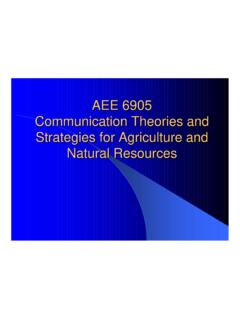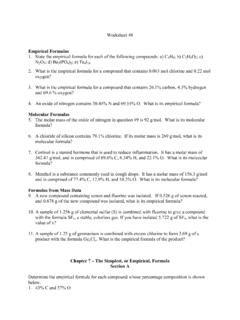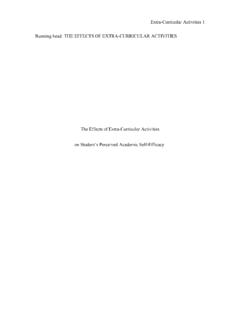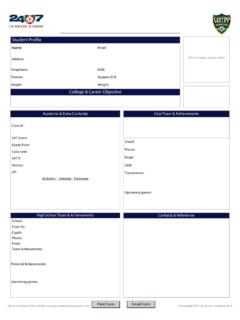Transcription of Participation in School-Based Extracurricular Activities ...
1 Foumat of Ijnsure Research Copyright 20052005, Vot. 37, No. I, pp. 51-76 National Recreation and Park AssociationParticipation in School-Based Extracurricular Activitiesand Adolescent AdjustmentNancy DarlingProgram in PsychologyBard CollegeLinda L. CaldwellSchool of Hotel, Restaurant, and Recreation ManagementThe Pennsylvania State UniversityRobert SmithDepartment of Human Development & Family StudiesThe Pennsylvania State UniversityThis paper examines the association between Participation in School-Based ex-tracurricular Activities (ECAs) and adolescent adjustment (drinking, marijuanause, grades, academic attitudes and academic aspirations) among students fromsix high schools.
2 Three major issues were addressed: the potential confoundingof selective ECA Participation by better adjusted students and measures of ad-justment, variability in the strength of the association between ECA participa-tion and adjustment as a function of adolescent demographic characteristicsand activity type, and the role of peers as mediators of the association betweenECA Participation and adjustment. Adolescents who participated in ECAs re-ported higher grades, more positive attitudes toward schools, and higher aca-demic aspirations once demographic characteristics and prior adjustment werecontrolled. Alcohol and marijuana use were not independently associated withECA Participation .
3 The ECA-adjustment association did not vary by demo-graphic characteristics and did not appear to be mediated by peer character-istics. Those who participated in non-sport ECAs reported consistently betteradjustment than those who did not participate in ECAs and those who partic-ipate in : Extracurricular Activities , adolescence, provides adolescents with unique developmental other social contexts, most notably school (Eccles, Lord, & Buchanan,1996), leisure is a context in which adolescents are encouraged to managetheir own experiences by exerting personal control over their environmentsand acting autonomously (Brown & Theobald, 1998; Silbereisen & Eyferth,1986).
4 Leisure also provides opportunities for identity exploration and skillAddress correspondence to: Nancy Darling, Program in Psychology, Bard College, Annandale-on-Hudson, NY 12504. Email: note: The author wishes to thank B. Bradford Brown, Sanford Dornbusch, andLaurence Steinberg for use of these data. Data collection was supported by grants to LaurenceSteinberg and B. Bradford Brown from the Department of Education through the NationalCenter on Effective Secondary Schools at the University of Wisconsin-Madison, and to SanfordM. Dornbtisch and P. Herbert Leiderman from the Spencer DARLING, CALDWELL AND SMITH building (Kleiber, 1999) as well as both social differentiation and paper examines one class of adolescent leisure: School-Based extracur-ricular Activities .
5 School-Based Extracurricular Activities provide highly struc-tured leisure environments, in which adolescents can exert control and ex-press their identity through choice of activity and actions within the setting,but which do not normally facilitate experimentation with roles and activitiesthat are not sanctioned by adults. Because of these characteristics, partici-pation in School-Based Extracurricular Activities provides many of the positivedevelopmental opportunities offered by other forms of leisure, but may pro-vide more protection against experimentation with problematic activitiessuch as drug or alcohol use than unstructured social leisure settings (Cald-well & Darling, 1999; Shann, 2001).
6 In addition, Participation in School-Based Extracurricular Activities may provide adolescents access to social net-works, Activities , resources, and equipment that would be otherwiseunavailable to and Stattin (2000) characterize highly structured Activities asincluding "regular Participation schedules, rule-guided engagement, direc-tion by one or more adult activity leaders, an emphasis on skill developmentthat is continually increasing in complexity and challenge, activity perform-ance that requires sustained active attention, and clear feedback on perform-ance" (pp. 114-115). These characteristics, according to Bronfenbrenner andMorris (1998) and Larson (2000), facilitate the development of initiative andlead to healthy adolescent development.
7 Many School-Based extracurricularactivities, such as sports, student publications, radio stations, or performinggroups, can be characterized as highly structured Activities . Although outsideof the narrowly defined academic curriculum ( , math, science, socialstudies, and English), Extracurricular Activities have traditionally been of-fered by schools as a way to offer developmental and leadership opportuni-ties for youth, and to build school spirit (see, for example, Dewey, 1916). Extracurricular Activities are seen as a way of offering academically giftedstudents a way of excelling within the school environment, a way for academ-ically challenged students to achieve within the school setting, and as a wayof creating a sense of shared community within schools.
8 The positive impactthat " Extracurricular " Activities can have on a school 's academic mission issometimes emphasized by use of the term "co-curricular" to describe non-academic School-Based Activities ( , Hovet & Vinton, 1993; Kezar & Mor-iarty, 2000; Wren, 1997), although the term "co-curricular" is sometimes lim-ited to Activities outside of the classroom explicitly designed to complementstudent Activities have been touted by their proponents as ena-bling youths to socialize with peers and adults, set and achieve goals, competefairly, recover from defeat, and resolve disputes peaceably (Carnegie Cor-poration of New York, 1992; Danish & CuUotta, 2000).
9 At the psychologicallevel, Dworkin, Larson, and Hansen (2003) argue that Extracurricular activ-ities stand out from other aspects of adolescents' lives at school because theyprovide opportunity for identity work, develop initiative, and allow youth toEXTRACURRICULAR Activities AND ADOLESCENT ADJUSTMENT 53learn emotional competencies and develop new social skills. At a more macrolevel, they argue that activity Participation also allows youth to form newconnections with peers and acquire social capital. In addition, extracurric-ular Activities are one ofthe few contexts in which adolescents regularly comein contact with unrelated adults outside of the classroom (for review, seeDarling, Hamilton, & Shaver, 2003).
10 The benefits of participating in structured leisure Activities are certainlynot limited to School-Based Extracurricular Activities . However, school -basedextracurricular Activities are unique in several ways. First, they are one of thefew aspects of leisure actively promoted by schools and are thus amenableto programmatic and social policy initiatives. For example, requirements forart, music, and physical education may expose youth to experiences that theymay not have at home, encourage them to enroll in School-Based extracur-ricular Activities such as band, theater, or sports, and enrich their leisureoutside of school .

















